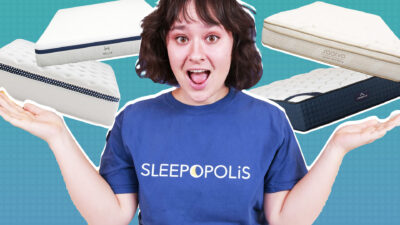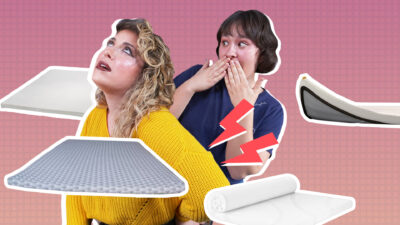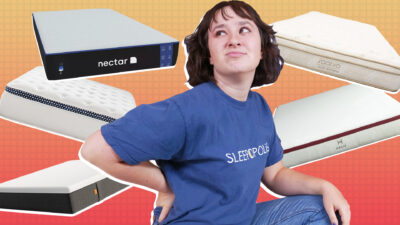How in the world are you supposed to sleep with pulsing pains shooting up your hips and legs? Aside from seeking the advice and treatment of a medical professional, one thing you can do is buy one of the best mattresses for sciatica. This isn’t any old mattress, but one that lifts your spine into a neutral alignment all the way from your shoulders to your hips.
If you suffer from sciatica, you know the pain that comes along with the condition can make sleeping comfortably quite the challenge. Since your sciatic nerve runs from the lower back, through the hips and the buttocks, down to the heels of your feet, it’s no joke when the pain strikes. Our team at Sleepopolis understands this struggle, and that’s why we created this guide. Here are our top picks to help you find the best mattress for sciatica.
Our Top Pick for Sciatica
Thanks to its pillow top, which is layered over memory foam, the Helix Dusk Luxe provides a soft, plush sleeping surface that takes pressure off your back. Meanwhile, the coils at the bottom of the mattress give you plenty of spinal support.
Best Mattresses for Sciatica 2024
- Helix Dusk Luxe – Best Overall Mattress for Sciatica
- Nectar – Best Memory Foam Mattress
- WinkBed – Best Hybrid Mattress for Sciatica
- Nolah Evolution – Best Mattress for Pressure Relief
- Plank Firm – Best Firm Mattress for Sciatica
- Saatva – Best Innerspring Mattress
- Titan Plus – Best Mattress for Heavy Sleepers
- Bear Elite Hybrid – Best Mattress for Muscle Recovery
- Brooklyn Bedding Signature Hybrid – Best Mattress for Couples
- Birch Luxe – Best Mattress for Hot Sleepers
Best Mattress for Sciatica 2024 – Our Video Roundup

Disclaimer: The content on Sleepopolis is meant to be informative, but shouldn’t replace advice or treatment from a medical professional. If you experience chronic pain or discomfort while sleeping, it’s best to consult a healthcare professional.
Compare the Best Mattresses For Sciatica
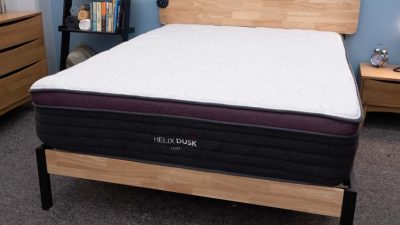
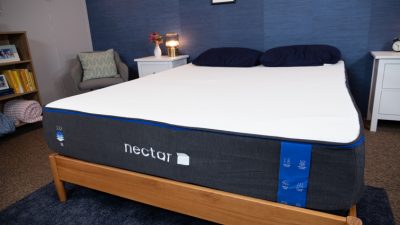
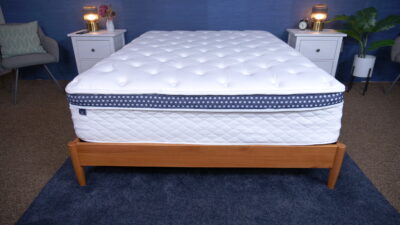
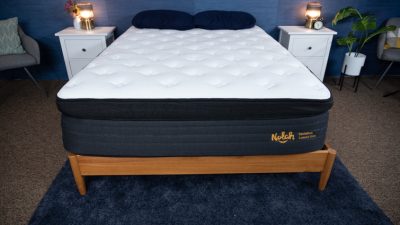
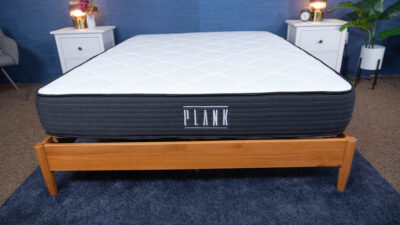
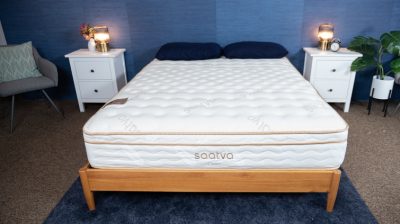
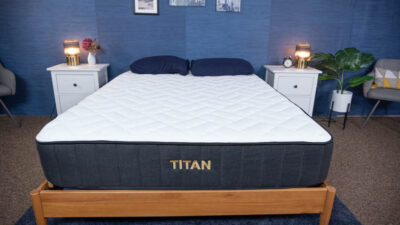
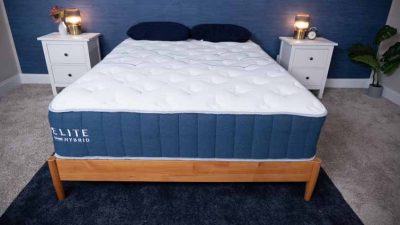
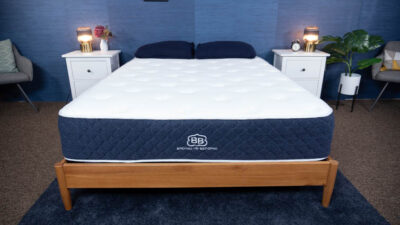
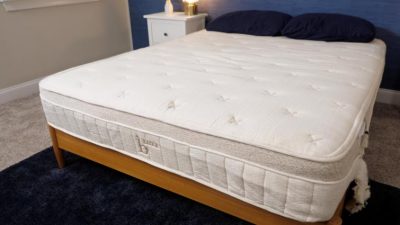
Helix Dusk Luxe Mattress
Nectar Mattress
WinkBed Mattress
Nolah Evolution Hybrid Mattress
Brooklyn Bedding Plank Firm Mattress
Saatva Mattress
Titan Plus
Bear Elite Hybrid Mattress
Brooklyn Bedding Signature Hybrid Mattress
Birch Luxe Natural Mattress
Rating
Firmness
Medium-firm: 6.5/10
Medium-soft: 6/10
Multiple firmness options
Multiple firmness options
Multiple firmness options
Multiple firmness options
Firm: 7.5/10
Multiple firmness options
Multiple firmness options
Firm: 7/10
Material
Hybrid
Foam
Hybrid
Hybrid
Foam
Innerspring
Hybrid
Hybrid
Hybrid
Hybrid
Cooling
✓
--
✓
--
--
✓
--
✓
--
--
Sleep Position
Combination
Back & Side
Combination
Back & Side
Back & Stomach
Back & Stomach
Back & Stomach
Back & Stomach
Back
Back & Stomach
Helix Dusk Luxe – Best Overall Mattress for Sciatica
Helix Dusk Luxe Mattress

The Helix Dusk Luxe mattress features great edge support and a medium-firm feel. It’s made with a top layer of latex-foam alternative making it more durable than traditional memory foam. It's also bouncy, which is a plus for combination sleepers.
Material
Hybrid
Trial Period
100 nights
Shipping Method
Free shipping
Firmness
Medium-firm: 6.5/10
Warranty
15-year warranty
Price Range
$$$$$
We recommend this mattress for the following sleeper types:
Hot Sleepers
If you often overheat while you sleep, this mattress should help you stay cool.Back Sleeping
Ideal for average weight and heavyweight back sleepers.Side Sleeping
Ideal for heavyweight side sleepers.Stomach Sleeping
Ideal for lightweight stomach sleepers.Financing Options
Financing options are available for this mattress.
Helix Dusk Luxe Mattress

The Helix Dusk Luxe mattress features great edge support and a medium-firm feel. It’s made with a top layer of latex-foam alternative making it more durable than traditional memory foam. It's also bouncy, which is a plus for combination sleepers.
Material
Hybrid
Warranty
15-year warranty
Firmness
Medium-firm: 6.5/10
Shipping Method
Free shipping
Trial Period
100 nights
Price Range
$$$$$
We recommend this mattress for the following sleeper types:
Hot Sleepers
If you often overheat while you sleep, this mattress should help you stay cool.Back Sleeping
Ideal for average weight and heavyweight back sleepers.Side Sleeping
Ideal for heavyweight side sleepers.Stomach Sleeping
Ideal for lightweight stomach sleepers.Financing Options
Financing options are available for this mattress.

Helix Dusk Luxe Mattress
The Helix Dusk Luxe mattress features great edge support and a medium-firm feel. It’s made with a top layer of latex-foam alternative making it more durable than traditional memory foam. It's also bouncy, which is a plus for combination sleepers.
Material
Hybrid
Firmness
Medium-firm: 6.5/10
Trial Period
100 nights
Warranty
15-year warranty
Shipping Method
Free shipping
Price Range
$$$$$
We recommend this mattress for the following sleeper types:
Hot Sleepers
If you often overheat while you sleep, this mattress should help you stay cool.Back Sleeping
Ideal for average weight and heavyweight back sleepers.Side Sleeping
Ideal for heavyweight side sleepers.Stomach Sleeping
Ideal for lightweight stomach sleepers.Financing Options
Financing options are available for this mattress.
Pros of the Helix Dusk
For a bit more money, you can get the Helix Dusk in a luxury version that comes with a pillow top and Tencel cover
The Dusk should sleep fairly cool, thanks to its airflow-promoting coils. The Helix Dawn Luxe sleeps even cooler due to its soft and breathable Tencel cover
The springs give the Helix Dusk a good deal of bounce and responsiveness that should make it easy for combination sleepers to change positions
Cons of the Helix Dusk
The softness of this mattress isn’t going to be an ideal fit for stomach sleepers. They’ll need something more supportive to keep their hips elevated and in line with their shoulders. See our best mattresses for stomach sleepers for more options
Likewise, heavy sleepers over 250 pounds will likely need a firmer and more supportive mattress. They should look at our best mattresses for heavy people
Helix has a line of six hybrid mattresses, each with a different level of firmness. The Dusk is one of their softer models. It has enough contouring for side sleepers, but should still be supportive enough for back sleepers, as long as they don’t mind a softer bed. Learn more in our video review of all the Helix mattresses.
What our tester says:
“Both Helix Dusk mattresses offer a balance of support and pressure relief that back sleepers should really appreciate. I personally enjoy a balanced feel, and I liked that these beds offer a nice blend of body contouring and bounce.” – Logan Block, former Sleepopolis content director and mattress tester
Expert Opinion
Helix sells a lot of different hybrid mattresses in a box, and has both a standard line and luxe line for each model. We think the Luxe line is the way to go for sciatica sufferers because, no matter which model you choose, it has a pillow top layer over its memory foam. For our top pick for lower back pain, we specifically recommend the Helix Dusk Luxe, as its medium firmness works for a lot of different sleepers. When lying down on its surface, the pillow top gave us some added plushness and pressure relief. We also think hybrid mattresses can be helpful for lower back pain because they offer the springy support that helps keep your spine aligned. After all, our pressure map lit up with blue in the lumbar region for back sleeping.
What our tester says: “I also appreciate the edge support in this bed. It’s a nice feature that makes your mattress feel a little bigger, and is a great indication that this bed is well-made. I’d expect this bed to last you a long time.” – Logan Block, former Sleepopolis director of content and mattress tester
What Customers Say
Several customers found Helix’s 30-second Sleep Quiz to be extremely helpful in deciding which hybrid worked for them.
Pros of the Helix Dusk Luxe Mattress
- Medium-firm mattresses tend to be a good fit for back sleepers, as they provide comfort and support for the spine.
- There’s enough responsiveness here for combination sleepers to be able to easily switch positions throughout the night.
- The coils promote airflow throughout the mattress’ structure, plus every bed in the Luxe line comes outfitted with a soft and breathable Tencel cover.
Cons of the Helix Dusk Luxe Mattress
- Side sleepers may want a slightly softer bed with just a little bit more contouring.
Ready to purchase? Click here to get the best deal. For more on the Helix Luxe line, check out our full Helix Dusk Luxe mattress review. You can also peruse our roundup of the best mattresses of 2024 for more choices.
Nectar – Best Memory Foam Mattress
Nectar Mattress

The original Nectar mattress is a pressure-relieving, yet supportive, bed. It’s made with a thick layer of gel memory foam, which allows the sleeper to really sink into its surface.
Material
Foam
Trial Period
365 nights
Shipping Method
Free shipping
Firmness
Medium-soft: 6/10
Warranty
Lifetime warranty
Price Range
$$$$$
We recommend this mattress for the following sleeper types:
Joint Pain
This bed is perfect for anyone suffering from joint pain.Hip Pain
This bed is perfect for anyone suffering from hip pain.Back Sleeping
Ideal for lightweight and average weight back sleepers.Side Sleeping
Ideal for lightweight and average weight side sleepers.Financing Options
Financing options are available for this mattress.
I dreaded paying for a new mattress but my old one was 15 years old…buying a Nectar was the best choice I could have made! It is so comfortable and didn’t cost an arm and a leg. I would absolutely recommend this mattress to anyone!
Kaitlynne S., Nectar customerNectar Mattress

The original Nectar mattress is a pressure-relieving, yet supportive, bed. It’s made with a thick layer of gel memory foam, which allows the sleeper to really sink into its surface.
Material
Foam
Warranty
Lifetime warranty
Firmness
Medium-soft: 6/10
Shipping Method
Free shipping
Trial Period
365 nights
Price Range
$$$$$
We recommend this mattress for the following sleeper types:
Joint Pain
This bed is perfect for anyone suffering from joint pain.Hip Pain
This bed is perfect for anyone suffering from hip pain.Back Sleeping
Ideal for lightweight and average weight back sleepers.Side Sleeping
Ideal for lightweight and average weight side sleepers.Financing Options
Financing options are available for this mattress.
I dreaded paying for a new mattress but my old one was 15 years old…buying a Nectar was the best choice I could have made! It is so comfortable and didn’t cost an arm and a leg. I would absolutely recommend this mattress to anyone!
Kaitlynne S., Nectar customer
Nectar Mattress
The original Nectar mattress is a pressure-relieving, yet supportive, bed. It’s made with a thick layer of gel memory foam, which allows the sleeper to really sink into its surface.
Material
Foam
Firmness
Medium-soft: 6/10
Trial Period
365 nights
Warranty
Lifetime warranty
Shipping Method
Free shipping
Price Range
$$$$$
We recommend this mattress for the following sleeper types:
Joint Pain
This bed is perfect for anyone suffering from joint pain.Hip Pain
This bed is perfect for anyone suffering from hip pain.Back Sleeping
Ideal for lightweight and average weight back sleepers.Side Sleeping
Ideal for lightweight and average weight side sleepers.Financing Options
Financing options are available for this mattress.
I dreaded paying for a new mattress but my old one was 15 years old…buying a Nectar was the best choice I could have made! It is so comfortable and didn’t cost an arm and a leg. I would absolutely recommend this mattress to anyone!
Kaitlynne S., Nectar customerPros of the Nectar
The soft foams should provide comfort to those with joint pain
It contours the body without sacrificing support, and should be comfortable for back sleepers and side sleepers
The Nectar has great motion isolation, so partners shouldn’t disturb each other by moving around
Cons of the Nectar
Like many soft mattresses, the Nectar probably isn’t supportive enough to be one of the best mattresses for stomach sleepers
It’s not the best mattress for combination sleepers. These folks may struggle to move around this mattress since it “hugs” you
Heavy sleepers who weigh over 250 pounds likely won’t feel supported and should check out our best mattresses for heavy people
The Nectar is a soft, all-foam mattress that contours the body and allows you to sink into the layers. It’s designed to cushion joints and alleviate pressure points while still providing spinal support, so it should be a great fit for back and side sleepers, and even couples who are concerned with motion transfer. If you want to learn more about the Nectar mattress, take a look at our video review.
What our tester says:
“Memory foam lovers should be happy on the Nectar. This bed has a classic memory foam feel, so there’s lots of sinkage, contouring, and pressure relief.” – Bridget Chapman, former Sleepopolis senior product editor
Expert Opinion
Memory foam beds are historically known for their ability to help alleviate pain, and the Nectar is no exception. We think this mattress is the best foam option for sciatica because it blends both comfort and support. Its construction consists of three separate foam layers, with memory foam up top to provide pain relief, and firmer high-density foam at the bottom to provide spinal support and prevent the sleeper from sinking too far into the material. A layer of soft conventional foam sits in the middle to help transition you between the other two layers. Our pressure map test showed especially great results for the back-sleeping position; those with sciatica should find a lot of relief on this mattress.
What our tester says: “The Nectar is a memory foam mattress, and embodies many of the traits these beds are famous for: a contouring and slow-sinking feel. But it also strives to excel in areas that memory foam mattresses often lack, especially support and cooling.” – Bridget Chapman, former senior product editor
What Customers Say
There are over 52,000 reviews of the Nectar on the brand’s website (and counting). It has an average customer rating of 4.7 out of 5 stars. You can actually search specific words in the reviews, and when typing in “sciatica”, 87 customer testimonials come up that praise how the bed alleviates pain associated with this condition.
Pros of the Nectar Mattress
- During testing, we found that many side sleepers should be comfortable on this mattress, too. They should get plenty of cradling at the shoulders and hips — the areas of the body where they put the most pressure.
- For a memory foam mattress, the Nectar is quite affordable. You can often find a queen size for under $1,000 after discounts.
- Because it’s made entirely of foam, the Nectar has excellent motion isolation. Partners will likely be able to move around without waking each other up.
Cons of the Nectar Mattress
- Heavier folks don’t tend to fare well on all-foam mattresses. They should look for something with at least one layer of springs in it that can offer more support.
Ready to purchase? Click here to get the best deal. And you can read the full Nectar review for our full testing results, or see some more choices on our best memory foam mattress page.
WinkBed – Best Hybrid Mattress For Sciatica
WinkBed Mattress

The WinkBed is a hybrid mattress that comes in three firmness levels, so most sleepers should find a model that suits their needs. It could also be a good fit for couples, thanks to reinforced edge support.
Material
Hybrid
Trial Period
120 nights
Shipping Method
Free shipping
Firmness
Multiple firmness options
Warranty
Lifetime warranty
Price Range
$$$$$
We recommend this mattress for the following sleeper types:
Hot Sleepers
If you often overheat while you sleep, this mattress should help you stay cool.Back Pain
This bed is perfect for anyone suffering from back pain.Back Sleeping
Ideal for lightweight and average weight back sleepers.Side Sleeping
Ideal for lightweight and average weight side sleepers.Stomach Sleeping
Ideal for average weight stomach sleepers.Financing Options
Financing options are available for this mattress.
Absolutely the greatest mattress I've ever slept on. It is soft yet firm in the right spots. Quality is on another level. You get what you pay for.
Sobhana P., WinkBeds customerWinkBed Mattress

The WinkBed is a hybrid mattress that comes in three firmness levels, so most sleepers should find a model that suits their needs. It could also be a good fit for couples, thanks to reinforced edge support.
Material
Hybrid
Warranty
Lifetime warranty
Firmness
Multiple firmness options
Shipping Method
Free shipping
Trial Period
120 nights
Price Range
$$$$$
We recommend this mattress for the following sleeper types:
Hot Sleepers
If you often overheat while you sleep, this mattress should help you stay cool.Back Pain
This bed is perfect for anyone suffering from back pain.Back Sleeping
Ideal for lightweight and average weight back sleepers.Side Sleeping
Ideal for lightweight and average weight side sleepers.Stomach Sleeping
Ideal for average weight stomach sleepers.Financing Options
Financing options are available for this mattress.
Absolutely the greatest mattress I've ever slept on. It is soft yet firm in the right spots. Quality is on another level. You get what you pay for.
Sobhana P., WinkBeds customer
WinkBed Mattress
The WinkBed is a hybrid mattress that comes in three firmness levels, so most sleepers should find a model that suits their needs. It could also be a good fit for couples, thanks to reinforced edge support.
Material
Hybrid
Firmness
Multiple firmness options
Trial Period
120 nights
Warranty
Lifetime warranty
Shipping Method
Free shipping
Price Range
$$$$$
We recommend this mattress for the following sleeper types:
Hot Sleepers
If you often overheat while you sleep, this mattress should help you stay cool.Back Pain
This bed is perfect for anyone suffering from back pain.Back Sleeping
Ideal for lightweight and average weight back sleepers.Side Sleeping
Ideal for lightweight and average weight side sleepers.Stomach Sleeping
Ideal for average weight stomach sleepers.Financing Options
Financing options are available for this mattress.
Absolutely the greatest mattress I've ever slept on. It is soft yet firm in the right spots. Quality is on another level. You get what you pay for.
Sobhana P., WinkBeds customerPros of the WinkBed Mattress
Back sleepers and stomach sleepers should get the support they need
Has a traditional, supportive feel
The WinkBed has cooling capabilities to help people who sleep hot
Sturdy edge support and good motion isolation make this a good choice for couples
Cons of the WinkBed Mattress
It lacks a contouring, slow-sinking feel that most associate with the best memory foam mattresses
It may be too pricey for some, and we recommend these shoppers browse the best mattresses under $1,000
The WinkBed is a luxury hybrid mattress. It has a similarly supportive and sturdy feel to a traditional innerspring mattress, but upgrades like a Euro top and cooling Tencel cover give it a touch of modern luxury. Available in three firmness levels, there is a WinkBed for just about every sleeper. And a responsive and bouncy feel makes it a great pick for combination sleepers. Learn more in our video review.
What our tester says:
“One of my favorite things about the WinkBed is its durability. This is a high-quality mattress that should really stand the test of time. This is great news for any sleeper, but especially nice for heavy people and couples.” – Bridget Chapman, former Sleepopolis senior product editor
Expert Opinion
Anyone looking to soothe their sciatic nerve while still feeling supported should definitely consider the WinkBed. Built with a combination of springs and foams, it has a pillow top and memory foam comfort layer that provided us with some nice pressure relief at the lower back. At the bottom of the mattress, a tall support layer of pocketed coils gave us a slight lift. The coils are zoned, meaning they’re able to give different areas of the back different levels of support.
We put each mattress through a host of tests, but one of the tests most helpful for this roundup is our pressure map test. This involves us spreading out a pressure mat across the mattress surface and using it to track areas of pressure buildup. Results show on a graphic that lights our silhouette in different colors: red and orange for high pressure, yellow for moderate pressure, and green and blue for low pressure. In the case of the WinkBed Luxury Firm, we saw lots of blue and a bit of green in the back sleeping position, indicating low pressure buildup. This should come in handy for those with sciatica, as the comfort layer should fill in the lumbar region and ease tension at the back.
What our tester says: “I really like the bouncy support this mattress offers. It should be a hit with combination sleepers who need some mobility to change positions at night. Anyone who likes a more traditional innerspring feel should find a lot to love in the WinkBed.” – Bridget Chapman, former senior product editor
What Customers Say
Shoppers with joint pain and back pain seem to find that the WinkBed helps alleviate their discomfort.
Pros of the WinkBed Mattress
- The WinkBed is available in four different models: Softer (best for side sleepers and back sleepers who like a softer feel), Luxury Firm (best for back sleepers who like a firmer feel), Firmer (best for stomach sleepers), and Plus (made for sleepers who weigh over 250 pounds).
- The tall coils in the Winkbed make it extra-bouncy and responsive, which makes it easy for combo sleepers to move around and switch sleeping positions.
- The coils leave plenty of space for airflow, and there’s an infusion of gel in both the comfort layer and the pillow top to assist with cooling.
Cons of the WinkBed Mattress
- The WinkBed has more of an “on top of” feel that probably isn’t going to appeal to folks who love the slow sinkage and contouring of memory foam.
Ready to purchase? Click here to get the best deal. You can also get more details in our full WinkBed mattress review, and see some other choices on our best hybrid mattresses page.
Nolah Evolution – Best for Pressure Relief
Nolah Evolution Hybrid Mattress

The Nolah Evolution provides good pressure relief and body contouring. It’s a great choice for side sleepers, and back sleepers who like a softer mattress will enjoy it too. The soft pillow top is a great touch for shoulder or hip pain as well.
Material
Hybrid
Trial Period
120 nights
Shipping Method
Free shipping
Firmness
Multiple firmness options
Warranty
Lifetime warranty
Price Range
$$$$$
We recommend this mattress for the following sleeper types:
Back Sleeping
Ideal for lightweight and average weight back sleepers.Side Sleeping
Ideal for lightweight and average weight side sleepers.Financing Options
Financing options are available for this mattress.
An amazing mattress! Constructed with luxuriously well made materials that are breathable and incredibly comfortable. After almost one year of sleeping on this mattress, my husband and I are still talking about how much we love it. We both are combo sleepers and feel it's the perfect balance between soft and firm. Plus, no more waking up with a sore back or tight neck. Would highly recommend!!
Hannah Merrifield, Nolah customerNolah Evolution Hybrid Mattress

The Nolah Evolution provides good pressure relief and body contouring. It’s a great choice for side sleepers, and back sleepers who like a softer mattress will enjoy it too. The soft pillow top is a great touch for shoulder or hip pain as well.
Material
Hybrid
Warranty
Lifetime warranty
Firmness
Multiple firmness options
Shipping Method
Free shipping
Trial Period
120 nights
Price Range
$$$$$
We recommend this mattress for the following sleeper types:
Back Sleeping
Ideal for lightweight and average weight back sleepers.Side Sleeping
Ideal for lightweight and average weight side sleepers.Financing Options
Financing options are available for this mattress.
An amazing mattress! Constructed with luxuriously well made materials that are breathable and incredibly comfortable. After almost one year of sleeping on this mattress, my husband and I are still talking about how much we love it. We both are combo sleepers and feel it's the perfect balance between soft and firm. Plus, no more waking up with a sore back or tight neck. Would highly recommend!!
Hannah Merrifield, Nolah customer
Nolah Evolution Hybrid Mattress
The Nolah Evolution provides good pressure relief and body contouring. It’s a great choice for side sleepers, and back sleepers who like a softer mattress will enjoy it too. The soft pillow top is a great touch for shoulder or hip pain as well.
Material
Hybrid
Firmness
Multiple firmness options
Trial Period
120 nights
Warranty
Lifetime warranty
Shipping Method
Free shipping
Price Range
$$$$$
We recommend this mattress for the following sleeper types:
Back Sleeping
Ideal for lightweight and average weight back sleepers.Side Sleeping
Ideal for lightweight and average weight side sleepers.Financing Options
Financing options are available for this mattress.
An amazing mattress! Constructed with luxuriously well made materials that are breathable and incredibly comfortable. After almost one year of sleeping on this mattress, my husband and I are still talking about how much we love it. We both are combo sleepers and feel it's the perfect balance between soft and firm. Plus, no more waking up with a sore back or tight neck. Would highly recommend!!
Hannah Merrifield, Nolah customerPros of the Nolah Evolution
Great for couples due to its good edge support and low motion transfer
Works for back sleepers who need good lumbar support
Side sleepers will appreciate the pressure relief
Cons of the Nolah Evolution
Too soft to be one of the best mattresses for stomach sleepers
Bargain hunters may find this to be a bit pricier and may want to stick to the best mattresses for the money
Doesn’t have a slow-moving memory foam feel that you’d find in the best memory foam mattresses
The Nolah Evolution’s hybrid construction offers the cushioning of memory foam with the responsiveness of coils. The Luxury Firm model is a good option for side and back sleepers due to its medium-firm feel, though there are Plush and Firm versions as well. Those who share a bed may also appreciate its low motion transfer, so you won’t be disturbed by a partner’s movements and its solid edge support to allow you to maximize surface area. For more information, check out our video review.
What our tester says:
“I laid down to rest on this mattress on my back — my primary sleep position. I felt comfortable, but also appreciated the cozy, plush top of the bed. After some time lying on my back, I switched over to my side. I didn’t find this position quite as comfortable, as I did feel some slight pressure buildup in my shoulder.” – Amelia Jerden, senior staff writer
Expert Opinion
The Nolah Evolution has not one, but two comfort layers, meaning it offers pressure relief for anyone living with lower back pain. In terms of material, one layer is made of a proprietary material called AirFoamIce — the brand’s version of memory foam that also has a graphite infusion for extra cooling. We received immediate pressure relief while lying down, all while feeling supported from a layer of coils at the bottom. The springs even have an additional edge support system, allowing you to spread out across the entire mattress without feeling like you’re going to fall off.
We put the Nolah Evolution through our pressure map test, and not surprisingly, we found some wonderful pressure relief in the back sleeping positions (almost all blue). When switching to our sides, we found more than sufficient pressure relief as well. Folks should feel cushioned and relieved from sciatica pain on this mattress.
What our tester says: “This mattress provides good pressure relief and body contouring, which made me feel really comfy but also supported. I think the cushiony pillow top could be beneficial for anyone dealing with pain.” – Bridget Chapman, former senior product editor
What Customers Say
Shoppers find that the zoned support on the Nolah Evolution helps distribute their bodyweight comfortably.
Pros of the Nolah Evolution Mattress
- The mattress is available in three different firmness levels: Plush, Luxury Firm, and Firm. We think the Plush is best for side sleepers, Luxury Firm is best for back sleepers, and Firm is best for stomach sleepers.
- AirFoamIce sleeps much cooler than memory foam. Paired with the airflow-promoting coils, it makes the Nolah Evolution an excellent match for hot sleepers.
- The Evolution is springy and responsive, meaning it should be easy for combo sleepers to switch positions.
Cons of the Nolah Evolution Mattress
- While partners should have no problem staying cool, they might feel each other moving around on the springs if they’re especially light sleepers.
Ready to evolve your sleep experience? Click here to get the best deal. You can also check out our full Nolah Evolution mattress review for more info.
Plank Firm – Best Firm Mattress for Sciatica
Brooklyn Bedding Plank Firm Mattress

The Plank mattress is an all-foam, flippable mattress with a firm side and an extra-firm side, which makes it great for both back sleepers and stomach sleepers. Both sides of the mattress should provide stomach sleepers with the right amount of support needed, while back sleepers will be happiest on the firm side.
Material
Foam
Trial Period
120 nights
Shipping Method
Free shipping
Firmness
Multiple firmness options
Warranty
10-year warranty
Price Range
$$$$$
We recommend this mattress for the following sleeper types:
Back Pain
This bed is perfect for anyone suffering from back pain.Stomach Sleeping
Ideal for average weight and heavyweight stomach sleepers.Financing Options
Financing options are available for this mattress.
This is my 4th foam mattress. Lasting firmness is one of the challenges I have come across with the mattresses. This is the most firm I have purchased and after a few weeks, I am still happy.
Ray, Brooklyn Bedding customerBrooklyn Bedding Plank Firm Mattress

The Plank mattress is an all-foam, flippable mattress with a firm side and an extra-firm side, which makes it great for both back sleepers and stomach sleepers. Both sides of the mattress should provide stomach sleepers with the right amount of support needed, while back sleepers will be happiest on the firm side.
Material
Foam
Warranty
10-year warranty
Firmness
Multiple firmness options
Shipping Method
Free shipping
Trial Period
120 nights
Price Range
$$$$$
We recommend this mattress for the following sleeper types:
Back Pain
This bed is perfect for anyone suffering from back pain.Stomach Sleeping
Ideal for average weight and heavyweight stomach sleepers.Financing Options
Financing options are available for this mattress.
This is my 4th foam mattress. Lasting firmness is one of the challenges I have come across with the mattresses. This is the most firm I have purchased and after a few weeks, I am still happy.
Ray, Brooklyn Bedding customer
Brooklyn Bedding Plank Firm Mattress
The Plank mattress is an all-foam, flippable mattress with a firm side and an extra-firm side, which makes it great for both back sleepers and stomach sleepers. Both sides of the mattress should provide stomach sleepers with the right amount of support needed, while back sleepers will be happiest on the firm side.
Material
Foam
Firmness
Multiple firmness options
Trial Period
120 nights
Warranty
10-year warranty
Shipping Method
Free shipping
Price Range
$$$$$
We recommend this mattress for the following sleeper types:
Back Pain
This bed is perfect for anyone suffering from back pain.Stomach Sleeping
Ideal for average weight and heavyweight stomach sleepers.Financing Options
Financing options are available for this mattress.
This is my 4th foam mattress. Lasting firmness is one of the challenges I have come across with the mattresses. This is the most firm I have purchased and after a few weeks, I am still happy.
Ray, Brooklyn Bedding customerPros of the Plank Firm
The Plank Firm often appears on many of our roundups pertaining to spinal health and back pain.
This mattress is a good choice for couples; it scored 4 out 5 or more for motion isolation, edge support, and cooling.
The quality materials, from its firm cover to its high-density foams, make it an extremely durable option.
Cons of the Plank Firm
Side sleepers won’t receive the proper cushioning or contouring on the Plank Firm. They should look at our best mattresses for side sleepers instead
It’s not the best mattress for alleviating joint pain because of its firmer feel — take a look at our best soft mattresses for alternative options
The Plank Firm is not only unique in that it’s one of the firmest mattresses out there, but it’s also flippable. Each side features tons of firm support, and the option to test out which side is best for you should largely appeal to back, stomach, combination sleepers, and those with larger body types. For more information, check out our video review.
What our tester says:
“The Plank Firm is a flippable mattress, so the five layers work double duty. The support layers on one side become the top layers when the mattress is flipped. When the logo is right side up, the firmer side is facing you.” – Bridget Chapman, former senior product editor
Expert Opinion
You might want a firm mattress if you’re a stomach sleeper, as firm mattresses are great for keeping the hips elevated. Or you might want one if you sleep on your back and don’t want to feel as though you’re sinking into your bed. Fortunately, a firmer mattress can also help sleepers with sciatica.
We’d like to point these folks toward the Plank Firm, an all-foam bed with a flippable design from Brooklyn Bedding. Per its name, this is meant to be one of the firmest beds out there, with both a Firm side and an Ultra Firm side. When lying down on the Plank, we felt extremely supported. In terms of exact firmness, we scored the Firm side a 7.5 out of 10 on our mattress firmness scale and the Ultra Firm side an 8.5 out of 10. We also found it to work for a number of heavy sleepers, as well as average weight sleepers.
What our tester says: “I really like that the Plank Firm is a flippable mattress with two firmness options. This makes it feel like you’re getting two beds for the price of one. I also think this is a great choice for anyone who loves a firm feel — if you’re looking for the firmest mattress out there, the ultra-firm side of the Plank is the way to go.” – Bridget Chapman, former senior product editor
What Customers Say
There are almost 3,000 reviews on Plank’s company site, and these firm mattress lovers seem to adore how the Plank Firm provides continual support throughout the night.
Pros of the Plank Firm Mattress
- The foams in the Plank Firm are highly responsive, making it easy for combo sleepers to switch positions at night.
- Average weight and heavy stomach sleepers should be most comfortable on the Ultra Firm side. They should feel the dense foam keeping their hips elevated and in line with their shoulders, which helps them maintain a neutral spinal alignment.
- We recommend that average weight and heavy back sleepers opt for the Firm side to get the right blend of comfort and support.
Cons of the Plank Firm Mattress
- Both sides of the Plank are going to be far too firm for side sleepers of any weight, as they need a softer bed so they can get the contouring they need at the shoulders and hips.
Ready to purchase? Click here to get the best deal. You can also read our Plank Firm mattress review for more information, or check out other options on our best firm mattress page.
Saatva – Best Innerspring Mattress
The Saatva’s coil-on-coil construction provides a classic innerspring feel. It's a good option for combo sleepers, who will want to feel free to switch positions and avoid feeling “stuck” in the mattress. It comes in three firmness levels, so you should be able to find one that suits your needs.
We recommend this mattress for the following sleeper types: Financing options are available for this mattress. We were skeptical of buying a mattress on line but it could not have gone any smoother. Anthony answered all of our questions during our many phone conversations. Delivery was prompt and went without a hitch. Best of all the mattress is so comfortable! I haven't had such a good night sleep in years. Highly recommend this.
The Saatva’s coil-on-coil construction provides a classic innerspring feel. It's a good option for combo sleepers, who will want to feel free to switch positions and avoid feeling “stuck” in the mattress. It comes in three firmness levels, so you should be able to find one that suits your needs.
We recommend this mattress for the following sleeper types: Financing options are available for this mattress. We were skeptical of buying a mattress on line but it could not have gone any smoother. Anthony answered all of our questions during our many phone conversations. Delivery was prompt and went without a hitch. Best of all the mattress is so comfortable! I haven't had such a good night sleep in years. Highly recommend this.
The Saatva’s coil-on-coil construction provides a classic innerspring feel. It's a good option for combo sleepers, who will want to feel free to switch positions and avoid feeling “stuck” in the mattress. It comes in three firmness levels, so you should be able to find one that suits your needs.
We recommend this mattress for the following sleeper types: Financing options are available for this mattress. We were skeptical of buying a mattress on line but it could not have gone any smoother. Anthony answered all of our questions during our many phone conversations. Delivery was prompt and went without a hitch. Best of all the mattress is so comfortable! I haven't had such a good night sleep in years. Highly recommend this.
Saatva Mattress

Material
Innerspring
Trial Period
365 nights
Shipping Method
Free white glove delivery
Firmness
Multiple firmness options
Warranty
Lifetime warranty
Price Range
$$$$$
Hot Sleepers
If you often overheat while you sleep, this mattress should help you stay cool.
Back Pain
This bed is perfect for anyone suffering from back pain.
Back Sleeping
Ideal for lightweight, average weight, and heavyweight back sleepers.
Stomach Sleeping
Ideal for lightweight and average weight stomach sleepers.
Financing Options
Saatva Mattress

Material
Innerspring
Warranty
Lifetime warranty
Firmness
Multiple firmness options
Shipping Method
Free white glove delivery
Trial Period
365 nights
Price Range
$$$$$
Hot Sleepers
If you often overheat while you sleep, this mattress should help you stay cool.
Back Pain
This bed is perfect for anyone suffering from back pain.
Back Sleeping
Ideal for lightweight, average weight, and heavyweight back sleepers.
Stomach Sleeping
Ideal for lightweight and average weight stomach sleepers.
Financing Options

Saatva Mattress
Material
Innerspring
Firmness
Multiple firmness options
Trial Period
365 nights
Warranty
Lifetime warranty
Shipping Method
Free white glove delivery
Price Range
$$$$$
Hot Sleepers
If you often overheat while you sleep, this mattress should help you stay cool.
Back Pain
This bed is perfect for anyone suffering from back pain.
Back Sleeping
Ideal for lightweight, average weight, and heavyweight back sleepers.
Stomach Sleeping
Ideal for lightweight and average weight stomach sleepers.
Financing Options
Pros of the Saatva Mattress
With three firmness options, most sleepers should find a Saatva model that works for them
The Saatva uses high-quality materials that will last you a long time
Its bouncy and responsive feel means it’s great for combination sleepers
The Saatva’s reinforced edges give it some of the best edge support we’ve ever seen
Cons of the Saatva Mattress
If you’re looking for lots of sinkage or amazing motion isolation, you’re better off with one of the best memory foam mattresses
None of the Saatva Classic models will likely be supportive enough for heavy stomach sleepers. For these folks, we recommend the Saatva HD
The Saatva’s coil-on-coil construction provides a classic innerspring feel. It’s a good option for combo sleepers, who will want to feel free to switch positions and avoid feeling “stuck” in the mattress. It comes in three firmness levels, so you should be able to find one that suits your needs. The white glove delivery Saatva provides is an added perk and will save you the headache of getting rid of your old mattress (they take it away for free!). For more information, watch our video review.
What our tester says:
“I thought the Saatva was super easy to move around on thanks to its coil layers and cushiony foam top. I found the Luxury Firm model to have a very supportive, yet plush feel that kept me comfortable in multiple sleep positions.” – Bridget Chapman, former Sleepopolis senior product editor
Expert Opinion
The Saatva is considered a luxury innerspring bed built with a coil-on-coil construction, meaning it has two layers of springs: a layer of larger steel coils below and a layer of smaller, individually wrapped coils above. When testing out the mattress, we felt these individually wrapped coils moving with our body, giving us pressure relief where we most needed it. The bed also has a layer of memory foam between its coil layers, which gave us extra relief at the lower back to help alleviate sciatica. During testing, we tried the pressure map test on the Luxury Firm version (firmer than the Plush Soft, softer than the Firm). We found overall good results for an innerspring bed. There was some moderate pressure building up at the lower back while back sleeping. And we noticed moderate pressure at our hip and shoulder while resting on our side. For extra pressure relief, we recommend trying the Plush Soft version.
What our tester says: “The Saatva Classic is a bouncy, high-quality mattress with durability and great edge support. I think it’s a nice option for back sleepers and combination sleepers. I also appreciate how the Saatva Classic comes in three different firmness levels and two different heights.” – Bridget Chapman, former senior product editor
What Customers Say
Customers highly value Saatva’s free white glove delivery. Saatva will help remove your old mattress and set up your new model, as well.
Pros of the Saatva Mattress
- The mattress is available in three different firmness levels. We generally recommend the Plush Soft for side sleepers, Luxury Firm for back sleepers, and Firm for stomach sleepers.
- We think the Saatva works well if you like to switch positions throughout the night too, since you’ll definitely feel more on top of this mattress than in it.
- Because the Saatva has so many springs, there’s more room in the bed for airflow than there is in an all-foam mattress. This helps the mattress stay nice and cool.
Cons of the Saatva Mattress
- Even the Plush Soft model is going to be firmer, bouncier, and more responsive than many foam beds. If you prefer the soft, sinking feel of memory foam, then you may want to look elsewhere.
Ready to purchase? Click here to get the best deal. You can also learn more in the full Saatva mattress review, or if you’re still searching for the perfect bed, check out our roundup of the best innerspring mattresses.
Titan Plus – Best Mattress for Heavy Sleepers
Titan Plus

The Titan Firm Hybrid from Brooklyn Bedding is a durable mattress featuring 6-inch heavy-duty support coils, making it a great option for heavier sleepers. This mattress also has a Titanflex foam comfort layer, which provides nice lift and bounce for heavier weights.
Material
Hybrid
Trial Period
120 nights
Shipping Method
Free shipping
Firmness
Firm: 7.5/10
Warranty
10-year warranty
Price Range
$$$$$
We recommend this mattress for the following sleeper types:
Back Pain
This bed is perfect for anyone suffering from back pain.Back Sleeping
Ideal for heavyweight back sleepers.Stomach Sleeping
Ideal for heavyweight stomach sleepers.Financing Options
Financing options are available for this mattress.
Get this bed right now! Simply amazing. Does not sag in the middle at all. Best sleep I've had in a very long time.
Shante, Brooklyn Bedding customerTitan Plus

The Titan Firm Hybrid from Brooklyn Bedding is a durable mattress featuring 6-inch heavy-duty support coils, making it a great option for heavier sleepers. This mattress also has a Titanflex foam comfort layer, which provides nice lift and bounce for heavier weights.
Material
Hybrid
Warranty
10-year warranty
Firmness
Firm: 7.5/10
Shipping Method
Free shipping
Trial Period
120 nights
Price Range
$$$$$
We recommend this mattress for the following sleeper types:
Back Pain
This bed is perfect for anyone suffering from back pain.Back Sleeping
Ideal for heavyweight back sleepers.Stomach Sleeping
Ideal for heavyweight stomach sleepers.Financing Options
Financing options are available for this mattress.
Get this bed right now! Simply amazing. Does not sag in the middle at all. Best sleep I've had in a very long time.
Shante, Brooklyn Bedding customer
Titan Plus
The Titan Firm Hybrid from Brooklyn Bedding is a durable mattress featuring 6-inch heavy-duty support coils, making it a great option for heavier sleepers. This mattress also has a Titanflex foam comfort layer, which provides nice lift and bounce for heavier weights.
Material
Hybrid
Firmness
Firm: 7.5/10
Trial Period
120 nights
Warranty
10-year warranty
Shipping Method
Free shipping
Price Range
$$$$$
We recommend this mattress for the following sleeper types:
Back Pain
This bed is perfect for anyone suffering from back pain.Back Sleeping
Ideal for heavyweight back sleepers.Stomach Sleeping
Ideal for heavyweight stomach sleepers.Financing Options
Financing options are available for this mattress.
Get this bed right now! Simply amazing. Does not sag in the middle at all. Best sleep I've had in a very long time.
Shante, Brooklyn Bedding customerPros of the Titan Plus
Heavy sleepers should find this mattress comfortable and supportive
It isolates motion well, so couples shouldn’t disturb each other as they move around on it
It’s responsive, so combination sleepers should move around easily on it
It’s durable and has great edge support — it should last for many years
Cons of the Titan Plus
Lightweight sleepers probably won’t get any pressure relief or contouring, so they might be better off with one of the best mattresses for lightweight sleepers
It doesn’t provide the best cooling benefits, unless you add the cooling cover for an extra cost. See the best cooling mattresses for more cooling options
The Titan Plus mattress is a durable mattress made with heavy sleepers in mind. It’s a firm and features heavy-duty coils and Titanflex foam that makes it bouncy and easy to move around on. But it still offers low motion transfer across the surface, so you shouldn’t feel disturbed by a partner or pet moving. The Titan Plus sleeps hotter than some hybrid mattresses, but the brand offers a cooling cover for an additional cost. For more information on the Titan Plus, check out our video review.
What our tester says:
“It’s not often you can find a bed that works for all sleeping positions, but the Titan Plus delivers this for heavy sleepers. I think it’d be a great fit for heavy combination sleepers or couples who are looking for support without sacrificing pressure relief.” – Bridget Chapman, former Sleepopolis senior product editor
Expert Opinion
Because heavy sleepers put more pressure on a mattress than lightweight or average weight sleepers, they usually need a bed with more firmness and support, especially if they struggle with lower back pain. They should find just that in the Titan Plus, a luxury hybrid mattress from Brooklyn Bedding designed specifically for larger body types over 250 pounds.
The construction of the Titan Plus consists of sturdy yet cushioning foams up top, with a tall layer of innerspring coils at the bottom. When we tested it out, we found that it offered us the support people with sciatica need, but also provided some pressure relief, thanks to its comfort layer of Titanflex foam. This is a proprietary material that simultaneously offers contouring and responsiveness.
What our tester says: “This mattress is certainly firm and would especially be a great fit for stomach sleepers. I felt like it kept my hips propped up and in line with my shoulders while stomach sleeping, ultimately ensuring spinal alignment and preventing back pain.” – Bridget Chapman, former senior product editor
What Customers Say
A lot of shoppers believe the Titan Plus to be an incredibly supportive and quality mattress for the price.
Pros of the Titan Plus Mattress
- As we noted, the Titan Plus was designed with heavier sleepers in mind, so they should be comfortable in most sleeping positions. However, folks under 250 pounds might have a different experience in regards to firmness and feel.
- If you sleep on your back and are of average weight (between 150 and 250 pounds), you should be comfortable on the Titan Plus. Our pressure map reassured us that the comfort layer should provide sufficient relief to the lumbar region.
- The same goes for average weight stomach sleepers.
Cons of the Titan Plus Mattress
- The Titan Plus is probably going to feel way too firm for average weight side sleepers. They’ll need something softer, with a lot more contouring at the shoulders and hips.
Ready to purchase? Click here to get the best deal. Interested in learning more? Read our full Titan Plus mattress review, or if you want some more options, check out our page of the best mattresses for heavy people.
Bear Elite Hybrid – Best Mattress for Muscle Recovery
Bear Elite Hybrid Mattress

The Bear Elite Hybrid is Bear's “ultra-luxurious” model with a traditional mattress feel, plus advanced cooling and support technology. It comes in three different firmness levels: Soft, Medium, and Firm.
Material
Hybrid
Trial Period
120 nights
Shipping Method
Free shipping
Firmness
Multiple firmness options
Warranty
Lifetime Warranty
Price Range
$$$$$
We recommend this mattress for the following sleeper types:
Hot Sleepers
If you often overheat while you sleep, this mattress should help you stay cool.Back Sleeping
Ideal for lightweight, average weight, and heavyweight back sleepers.Stomach Sleeping
Ideal for lightweight and average weight stomach sleepers.Financing Options
Financing options are available for this mattress.
Love it! I absolutely love this mattress and the adjustable frame. It’s helping my back issues so much. I highly recommend this mattress to anyone with back pain
Elise M., Bear customerBear Elite Hybrid Mattress

The Bear Elite Hybrid is Bear's “ultra-luxurious” model with a traditional mattress feel, plus advanced cooling and support technology. It comes in three different firmness levels: Soft, Medium, and Firm.
Material
Hybrid
Warranty
Lifetime Warranty
Firmness
Multiple firmness options
Shipping Method
Free shipping
Trial Period
120 nights
Price Range
$$$$$
We recommend this mattress for the following sleeper types:
Hot Sleepers
If you often overheat while you sleep, this mattress should help you stay cool.Back Sleeping
Ideal for lightweight, average weight, and heavyweight back sleepers.Stomach Sleeping
Ideal for lightweight and average weight stomach sleepers.Financing Options
Financing options are available for this mattress.
Love it! I absolutely love this mattress and the adjustable frame. It’s helping my back issues so much. I highly recommend this mattress to anyone with back pain
Elise M., Bear customer
Bear Elite Hybrid Mattress
The Bear Elite Hybrid is Bear's “ultra-luxurious” model with a traditional mattress feel, plus advanced cooling and support technology. It comes in three different firmness levels: Soft, Medium, and Firm.
Material
Hybrid
Firmness
Multiple firmness options
Trial Period
120 nights
Warranty
Lifetime Warranty
Shipping Method
Free shipping
Price Range
$$$$$
We recommend this mattress for the following sleeper types:
Hot Sleepers
If you often overheat while you sleep, this mattress should help you stay cool.Back Sleeping
Ideal for lightweight, average weight, and heavyweight back sleepers.Stomach Sleeping
Ideal for lightweight and average weight stomach sleepers.Financing Options
Financing options are available for this mattress.
Love it! I absolutely love this mattress and the adjustable frame. It’s helping my back issues so much. I highly recommend this mattress to anyone with back pain
Elise M., Bear customerPros of the Bear Elite Hybrid
Thick comfort layers provide lots of pressure relief while coils lift the hips for spinal support
The Medium model has a medium-soft feel that should suit most back and side sleepers
A responsive feel makes this bed easy to move on
Cons of the Bear Elite Hybrid
Heavyweight stomach sleepers won’t get enough support. See our best mattresses for heavy people for better options
As a luxury mattress with many special features, the Bear Elite Hybrid is priced higher. Budget shoppers may want to check out the best cheap mattresses instead
The Bear Elite Hybrid uses foam and coils for a mix of support, cushioning, and cooling. While designed for athletes prioritizing wellness and recovery, sleepers of all activity levels can enjoy the many luxurious features. Enjoy zoned support for targeted relief, an “on top of” feel allowing for ease of movement, and cooling features throughout. For more information, watch our video review.
What our tester says:
“I tested the Medium model and found that it’s a good match for most average-weight back and side sleepers. It has a balanced foam feel, and it offers a good blend of comfort and support.” – Bridget Chapman, former Sleepopolis senior product editor
Expert Opinion
Due to their active lifestyles, athletes are often subject to pain in the lower back and sciatic nerve. But they might find the relief they’re looking for in the Bear Elite Hybrid. We found that this mattress gave us the proper amount of contouring and pressure relief, all while creating support with a bottom layer of pocketed coils. But its real standout feature is a cover made of Celliant, a material that some recent research suggests may assist with blood flow and muscle recovery after a long workout or sporting match.
In terms of pressure relief, we found some promising results for the Bear Elite Hybrid. Our pressure map graphic presented an entirely blue silhouette in the back sleeping position, showing this should be a solid match for back sleeping and sciatica. When resting on our sides, we saw the slightest bit of green and yellow at the shoulder and hip, so folks with pain in this position should find comfort as well.
What our tester says: “I’d say the Bear Elite [Medium model] is a good choice for back sleepers with back pain. However, I’d also recommend trying out the Firm model to provide extra support for the lumbar region. Side sleepers with back pain are likely going to want to try the Soft model and stomach sleepers with back pain would do better on the Firm model.” – Bridget Chapman, former senior product editor
What Customers Say
Many side and back combination sleepers find comfort in both positions, and find it easy to move around at night.
Pros of the Bear Elite Hybrid Mattress
- As long as they enjoy a softer bed, back sleepers can get the comfort and support they need from the Bear Star Hybrid.
- Celliant’s recovery technology sleeps extremely cool. The coils also make for plenty of airflow, which makes this one cool-sleeping mattress.
- We scored the Bear Star Hybrid a 6 out of 10 on our mattress firmness scale, so side sleepers can rest assured that there’s plenty of pressure relief here, especially at the shoulders and hips.
Cons of the Bear Elite Hybrid Mattress
- The Bear Elite Hybrid is a luxury mattress with a higher price point. If you have a strict budget, you may want to opt for another option on this list.
Ready to hibernate on the Bear Elite Hybrid? Click here to get the best deal. You can also learn more in our full Bear Elite Hybrid mattress review, or check out our options on our best mattress for athletes page.
Brooklyn Bedding Signature Hybrid – Best Mattress for Couples
Brooklyn Bedding Signature Hybrid Mattress

The Brooklyn Bedding Signature is a hybrid mattress made out of a combination of memory foam and latex foam. The Signature offers a good amount of bounce that combination sleepers who move around in the middle of the night can enjoy.
Material
Hybrid
Trial Period
120 nights
Shipping Method
Free shipping
Firmness
Multiple firmness options
Warranty
10-year warranty
Price Range
$$$$$
We recommend this mattress for the following sleeper types:
Couples
This bed has great motion isolation so you will not feel your partner tossing and turning at night.Back Sleeping
Ideal for average weight back sleepers.Financing Options
Financing options are available for this mattress.
I bought this for my 92 year old father in law, after he tried mine that I purchased 7 years ago. He raves about it every day, he says he falls asleep faster, sleeps longer without waking up. He says it's so comfortable. He called me yesterday saying he can't thank me enough for setting him up with the mattress. He's really happy with it . Thank you!!
Roger S., Brooklyn Bedding customerBrooklyn Bedding Signature Hybrid Mattress

The Brooklyn Bedding Signature is a hybrid mattress made out of a combination of memory foam and latex foam. The Signature offers a good amount of bounce that combination sleepers who move around in the middle of the night can enjoy.
Material
Hybrid
Warranty
10-year warranty
Firmness
Multiple firmness options
Shipping Method
Free shipping
Trial Period
120 nights
Price Range
$$$$$
We recommend this mattress for the following sleeper types:
Couples
This bed has great motion isolation so you will not feel your partner tossing and turning at night.Back Sleeping
Ideal for average weight back sleepers.Financing Options
Financing options are available for this mattress.
I bought this for my 92 year old father in law, after he tried mine that I purchased 7 years ago. He raves about it every day, he says he falls asleep faster, sleeps longer without waking up. He says it's so comfortable. He called me yesterday saying he can't thank me enough for setting him up with the mattress. He's really happy with it . Thank you!!
Roger S., Brooklyn Bedding customer
Brooklyn Bedding Signature Hybrid Mattress
The Brooklyn Bedding Signature is a hybrid mattress made out of a combination of memory foam and latex foam. The Signature offers a good amount of bounce that combination sleepers who move around in the middle of the night can enjoy.
Material
Hybrid
Firmness
Multiple firmness options
Trial Period
120 nights
Warranty
10-year warranty
Shipping Method
Free shipping
Price Range
$$$$$
We recommend this mattress for the following sleeper types:
Couples
This bed has great motion isolation so you will not feel your partner tossing and turning at night.Back Sleeping
Ideal for average weight back sleepers.Financing Options
Financing options are available for this mattress.
I bought this for my 92 year old father in law, after he tried mine that I purchased 7 years ago. He raves about it every day, he says he falls asleep faster, sleeps longer without waking up. He says it's so comfortable. He called me yesterday saying he can't thank me enough for setting him up with the mattress. He's really happy with it . Thank you!!
Roger S., Brooklyn Bedding customerPros of the Brooklyn Bedding Signature Hybrid
It’s a good choice for budget shoppers. With a discount, queen sizes are often under $1,000
Back sleepers should find both comfort and support on the Medium model, which can help alleviate back pain
Brooklyn Bedding offers this bed in different firmnesses, making it a versatile option
The combination of coils and foam makes this mattress very easy to move around on
Cons of the Brooklyn Bedding Signature Hybrid
It doesn’t have that sinking-in feeling often found in the best memory foam mattresses
The Medium mattress is too firm for side sleepers and too soft for stomach sleepers (though the Soft or Firm model may work, respectively
The Brooklyn Bedding Signature Hybrid mattress combines a foam comfort layer and study coils. This combination of materials makes it bouncy and easy to move around on. It comes in three firmness levels, and we recommend the Medium model for most back sleepers. It’s a great choice for shoppers who are looking for a new mattress on a budget. . For more information, check out our video review.
What our tester says:
“I like that this mattress offers an ‘on-top-of-the-bed,’ plush feel. I think it’s a great choice for combination sleepers who need a mattress that makes it easy to change positions at night. I also appreciate that the Brooklyn Signature Hybrid mattress isolates motion well, has strong edge support, and sleeps fairly cool.” – Bridget Chapman, former Sleepopolis senior product editor
Expert Opinion
The three factors that we find to be most important when looking for a mattress for couples are firmness, motion isolation, and edge support. The Brooklyn Bedding Signature Hybrid excels in all of these areas. We found that it had a medium firmness that gave us a blend of comfort and support, the edge support was strong, and when we used a seismometer to measure how much it transfers movement across the mattress’ surface, it showed very low vibrations. But we also found it to be a good option for sleepers experiencing back pain and sciatica. They may get just enough contouring from the quilted top and memory foam layer while also getting a lift from the support layer of individually encased coils. Both of these factors help soothe the sciatic nerve and keep the spine in a neutral alignment.
What our tester says: “I appreciate that the Brooklyn Signature Hybrid mattress isolates motion well, has strong edge support, and sleeps fairly cool. All these features make me think this bed is a great choice for couples.” – Bridget Chapman, former senior product editor
What Customers Say
Couples make up a lot of the 10,000+ reviews on the Signature Hybrid’s page, and many of them have great things to say about the motion isolation and overall support.
Pros of the Brooklyn Bedding Signature Hybrid Mattress
- Folks who need to change positions at night should be able to do so easily on the Brooklyn Bedding Signature Hybrid, thanks to its responsive coils.
- The Signature Hybrid is actually available in three different firmness levels: Soft, Medium, and Firm. Side sleepers should be most comfortable on the Soft.
- As long as they prefer an on-top-of-the-bed feel, back sleepers should be comfortable on the Medium model of the Signature Hybrid.
Cons of the Brooklyn Bedding Signature Hybrid Mattress
- The Brooklyn Bedding Signature Hybrid is a fairly streamlined bed without a lot of extra features. If you’re someone who prefers added luxury, we recommend our list of the best luxury mattresses instead.
Ready to purchase? Click here to get the best deal. You can also read our Brooklyn Bedding Signature Hybrid review for more information, or check out other options on our best mattress for couples page.
Birch Luxe – Best Mattress for Hot Sleepers
Birch Luxe Natural Mattress

The Birch Luxe mattress is an eco-friendly and plush hybrid mattress by Helix Sleep. It's designed to sleep cool and assist with muscle recovery.
Material
Hybrid
Trial Period
100 Nights
Shipping Method
Free shipping
Firmness
Firm: 7/10
Warranty
25-year warranty
Price Range
$$$$$
Birch Luxe Natural Mattress

The Birch Luxe mattress is an eco-friendly and plush hybrid mattress by Helix Sleep. It's designed to sleep cool and assist with muscle recovery.
Material
Hybrid
Warranty
25-year warranty
Firmness
Firm: 7/10
Shipping Method
Free shipping
Trial Period
100 Nights
Price Range
$$$$$

Birch Luxe Natural Mattress
The Birch Luxe mattress is an eco-friendly and plush hybrid mattress by Helix Sleep. It's designed to sleep cool and assist with muscle recovery.
Material
Hybrid
Firmness
Firm: 7/10
Trial Period
100 Nights
Warranty
25-year warranty
Shipping Method
Free shipping
Price Range
$$$$$
Pros of the Birch Natural
Organic mattress with numerous GOTS and GREENGUARD Gold certifications
Naturally cooling Talalay latex in its transition layer
Enough firmness and strong support for anyone experiencing back pain
Enough responsiveness for combination sleeping
Ideal for anyone looking for a firmer, more “on top of the bed” feel
Cons of the Birch Natural
This isn’t one of the best mattresses for side sleepers, which have a softer feel that better cushions the joints
Higher price point — one of the best cheap mattresses might be better
You won’t find the slow sinkage many look for in the best memory foam mattress
The Birch Natural is a latex mattress utilizing individually wrapped coils for added support. This mattress specializes in cooling and responsiveness, and the firmer nature suits back and stomach sleepers well. Perhaps the most special part about this mattress is the material quality. Not only is the Birch organic, but it has also earned multiple certifications for safe production and materials. For more information, check out our video review.
What our tester says:
“One of my favorite things about the Birch is how cooling it is. I think any hot sleeper will be satisfied by this breathable bed. It’s definitely one of the most cooling mattresses available thanks to its wool and latex layers. These cooling materials also make it one of my favorite organic mattresses.” – Madison Schaper, Sleepopolis staff writer
Expert Opinion
If you not only live with lower back pain or sciatica, but you also tend to overheat while sleeping, it’s a good idea to opt for a mattress that’s cooling. The last thing sleepers with pain need is to wake up sweating in the middle of the night. We think the Birch Luxe is great for back pain because it has a firmer, supportive feel, but good pressure relief around the lower back due to its comfort layer of natural latex. Simultaneously, the zoned coils provided us with adequate firmness in the right places. And as the luxury version of the standard Birch, it has plenty of opulent touches such as a cover made of organic cotton, cashmere, and wool.
What our tester says: “If you change sleeping positions throughout the night, then this mattress could be a nice fit for you. It’s bouncy and responsive, allowing for easy movement on the bed. I also think hot sleepers would enjoy this mattress. It has organic cashmere and individually wrapped, pocketed coils to help with breathability.” – Bridget Chapman, former senior product editor
What Customers Say
Reviewers found the Birch Luxe to sleep cool enough to keep them at a comfortable temperature throughout the night.
Pros of the Birch Luxe Mattress
- The Birch Luxe is made with materials that are less harmful to the environment, such as naturally sourced latex, organic cotton, and organic cashmere.
- Moisture-wicking wool in the comfort layer, naturally cooling latex in the relief layer, and breathable coils all contribute to the Birch Luxe’s cooling abilities.
- There’s a lot of firmness and support on the Birch Luxe, which should help keep back sleepers’ and stomach sleepers’ spines neutrally aligned.
Cons of the Birch Luxe Mattress
- The mattress’ firm and responsive feel probably isn’t going to give side sleepers the contouring they need at the shoulders and hips.
Ready to purchase? Click here to get the best deal. For more information, head on over to our main Birch Luxe mattress review. You can also see more options for hot sleepers on our best cooling mattress page.
What is Sciatica?
Now that we’ve gone over our picks, let’s chat a bit about sciatica. For those unfamiliar with the term, it refers to pain, burning, or prickling sensation along the sciatic nerve, which runs from the lower back down either one or both legs. The most common cause is a herniated disk pressing against the nerve, activating a pain response from the body.
You Know Your Body Best
Remember, we’re sleep experts — not medical experts. If something feels wrong, talk to your doctor. If you think you may be experiencing sciatica, don’t hesitate to seek help!
If you’ve never experienced the pain before, it can feel like a tingling numbness or burning that can range in intensity from mild to excruciating. Though uncomfortable, it is treatable, either by medication, surgery, or more conservative measures like physical therapy. One way to mitigate sciatic irritation is to invest in a highly supportive mattress, which lifts the hips in alignment with the shoulders and helps provide uniform pressure relief across the body.
What to Look for In a Mattress for Sciatica
One way to mitigate sciatic irritation is to invest in a good mattress with features that can help alleviate your pain. Let’s take a closer look at what traits you should be seeking out.
Pressure Relief
As important as support is when finding the best mattress for sciatica and lower back pain, it should also offer some pressure relief. This can be accomplished with soft foams implemented into the construction, even if there’s a layer of springs. Most hybrid mattresses use a combination of foam and coils to strike the delicate balance between comfort and support.
Firmness
While the right firmness is always going to depend on a sleeper’s individual preference, we recommend that folks dealing with lower back pain look for something medium firm or higher. For context, the industry standard for medium firm is 6.5 out of 10 on our mattress firmness scale. That’s why most of the mattresses on this list are at least medium firm or come with several different firmness options available. If you prefer a soft mattress, we don’t recommend going lower than a 6 out of 10 on the mattress firmness scale.
Support
Sleepers who suffer from lower back pain and sciatica will want to look for a highly supportive mattress, which lifts the hips in alignment with the shoulders and evenly distributes your weight across the bed’s surface. Generally, hybrid and innerspring mattresses tend to be more supportive than all-foam mattresses, although there are certainly exceptions to the rule. When testing out a bed’s support, see how far you’re sinking into the bed. You don’t want to feel like you’re being swallowed up or bottoming out.
Sleeping Position
Side sleeping is perhaps the best sleeping position for sciatica, because it helps alleviate pressure buildup at your lower back. To really cushion those joints, we recommend a softer mattress that specializes in pressure releif.
We recognize that sometimes, it’s impossible to stray from your normal sleeping position. If you’re a devoted back-sleeper, search for a mattress with a medium firmness that elevates the hips but also cushions them. Strict stomach-sleepers will need a much firmer mattress that helps the body stay lifted throughout the night. Back pain can be alleviated or prevented simply by having the right mattress.
Body Type
Lightweight sleepers under 130 pounds typically fare best on a mattress with a softer feel. They don’t require quite as much support as heavier sleepers, so a soft mattress can still provide a good balance of durability and comfort for them. Average-weight sleepers typically do well on mattresses that are set at a medium firmness, and heavier sleepers typically need a firmer, more supportive mattress, since they compress more of the mattress layers.
How Your Body Type Impacts Sciatica
The Mayo Clinic states that sciatica most impacts overweight sleepers, as these folks experience additional strain on their backs from being overweight.
To remedy this, the Mayo Clinic recommends staying active, making sure to stand throughout the day, and keeping a straight spine while sitting.
Motion Isolation
The term “motion isolation” refers to how well a mattress is able to muffle a sleeper’s movement so that it doesn’t ripple across the bed. Couples where one person is a light sleeper often look for a mattress with good motion isolation, as to not be disturbed by their partner’s tossing and turning.
When it comes to finding a good mattress for lower back pain and sciatica, motion isolation isn’t as important as ease of movement. You’ll want something that makes it easy to get in and out of bed without exacerbating your pain. Hybrid mattresses — especially ones made with latex — excel at this. The downside is that they’re not as adept at isolating motion as foam mattresses.
What Makes a Great Mattress for Couples?
We suggest selecting a mattress that checks most if not all of these boxes: solid edge support, good motion isolation, sufficient cooling ability, and some responsiveness. The edge support reinforces the perimeter is great for making full use of the mattress, good motion isolation quiets your partner’s movements, a cooling bed takes down the body heat of two, and the responsiveness is ideal for sex.
Price
Most mattresses cost between $500–$1,500. While many great orthopedic mattresses can go above the $1,000 range, there are plenty of affordable options. For more ideas, see our roundups for the best mattresses for back pain.
Materials
As we’ve said, hybrid mattresses that contain soft foams and coils are usually going to be a sensible option for sleepers with lower back pain and sciatica, as they tend to offer an optimal blend of comfort and support. But there are some all-foam mattresses that could also work, a few of which are included in this article. The plus side to a foam bed is that it’s probably going to offer a ton of deep pressure relief. You’ll just want to make sure it has enough support.
Temperature Regulation
While temperature doesn’t necessarily cause or even relate to sciatica, it can result in a more uncomfortable sleeping experience. If you’re struggling with lower back pain and sleeping hot, you’re not likely to get a good night’s rest. So it’s not a bad idea to look for a mattress that has some nice cooling features.
Edge Support
Edge support refers to the strength of a mattress’ perimeter. A bed with strong edge support allows you (and possibly a partner) to spread out and utilize its entire surface without feeling like you’re going to fall off. To test a mattress’ edge support, simply sit on the edge of the bed and see if it collapses or sags under your weight. If it stays sturdy, then its edge support is strong.
A mattress with good edge support can be extremely helpful to folks dealing with sciatica. If they’re able to spread out and not feel cramped, they’re not as likely to experience a flare-up of their pain.
What Type of Mattress Is Best for Sciatica?
In truth, there’s no singular best mattress for sciatica. However, different types of mattresses have different pros and cons when it comes to finding the right comfort level.
Memory Foam
Memory foam mattresses are great options for sciatica because these mattresses specialize in pressure relief. This is crucial for anyone suffering from pain relief, as the foam can prevent the buildup of pain and pressure around sensitive areas. One potential drawback is that the wrong memory foam mattress can sag prematurely; so, make sure you select a durable option (specifically with high-density foam) that can support a neutral spinal alignment in the long-term.
Hybrid
Hybrid mattresses are fantastic for sciatica sufferers looking for a bit more support, as they combine cushioning foams with sturdy coils. This provides the pressure relief required for pain relief, but also the support to keep the hips lifted and properly aligned throughout the night.
Innerspring
Innerspring mattresses specialize in their firm support. While this might be okay for heavyweight sciatica pain sufferers, most sleepers with sciatica will likely find innersprings to be too firm. They may not provide the necessary pressure relief and cushioning, as innersprings have thin comfort layers. If you’re already sleeping on an innerspring, we recommend softening it with one of the best mattress toppers.
Latex
Latex mattresses aren’t just good for eco-conscious shoppers. They’re also stellar options for those with sciatica pain, as they’re incredibly durable options that often include cushioning latex foam. The more responsive feel can be great for combination sleepers, but they generally have poorer motion transfer. This can be a negative for couples who think they’d wake up easily from their partner’s tossing and turning.
Airbed
No, airbeds are not the same as air mattresses. Airbeds are generally on the pricier side, but reasonably so; they have air channels that are often remote-controlled to adjust the firmness of the mattress in real time. This means that regardless of what kind of sleeper you are, you should find great comfort on a versatile airbed.
How Your Sleep is Affected by Sciatica
As with all types of pain, sciatica and lack of sleep can quickly become a vicious cycle. If you have pain problems, you might have trouble falling or staying asleep. Poor sleep, in turn, can exacerbate pain, and so the cycle continues. That’s why it’s so important to invest in a quality mattress; it can quite literally change your life.
How Sleeping Positions Impact Sleeping With Sciatica
For additional information, check out our Guide to Better Sleep Posture.
Side Sleepers
Side sleeping is one of the best sleeping positions for sciatica, as it alleviates the pressure buildup at the lower back. If there’s a side that hurts the most (and with sciatica, there usually is), we recommend having that side face the ceiling. For this sleeping position, we recommend a softer feel, as it helps take pressure off of sensitive areas and can prevent a buildup of pain.
Back Sleepers
Back-sleeping can be helpful for sciatica and back pain as the body’s weight is more evenly distributed across the mattress, preventing a buildup of pressure on a particular area of the body. For added comfort and reinforced spinal alignment, we recommend adding a pillow underneath your knees.
Stomach Sleepers
Overall, we don’t recommend stomach-sleeping. It’s one of the most unhealthy sleeping positions for back pain, since there’s a high risk of your hips dipping too far into the mattress and throwing your spine out of alignment. If you are unable to adjust to a new sleeping position, we definitely recommend ensuring your sleeping surface is firm enough to prevent the hips from sinking too far into the material.
Combination Sleepers
You might find yourself tossing and turning while you sleep simply because you experience discomfort as a sciatica sufferer. But if you already have the proper mattress and just identify as a combination sleeper, then we recommend getting a mattress with more of an “on top of” feel. A responsive, bouncy bed should help with ease of movement. That way, you don’t have to strain yourself to get comfortable.
How to Relieve Sciatica in Bed
Use A Pillow
If you’re a back sleeper, using a pillow beneath the knees can further support a neutral spinal alignment and prevent an increase in sciatic pain. Side sleepers can use a pillow between their knees to prevent straining and further aggravating your lower back. For specifics, seek our Guide to a Better Sleep with Lower Back Pain.
Stretch Before Bed
Stretching before you sleep can be a great option for sciatica sufferers, taking away stress from the lower back. For more information, see our guide on sleep relaxation.
Use a Mattress Topper
Utilizing a mattress topper can be great for those experiencing discomfort on their current mattress. If you’re unable to afford a more comfortable mattress at the moment, a mattress topper can alter the firmness for cheap. The best mattress toppers can make your bed softer or firmer, and this can help you reach an ideal firmness that’s comfortable for you and your pain needs.
FAQs
What type of mattress is best for sciatica?
Folks with sciatica will want a medium-firm mattress that offers a mix of comfort and support. They’ll also want a little bounce to make sure they can easily change positions to avoid pressure point formation.
Can sciatica be caused by a bad mattress?
While a mattress won’t technically “cause” sciatica, an old or sagging bed can definitely make the symptoms worse. If you feel as though your mattress is no longer supporting your shoulders, hips, or lower back, it may be time to buy a new bed.
How do I know if my mattress is causing me back pain?
The most important thing to figure out is whether or not your mattress is supporting you in your preferred sleeping position. A lack of support can lead to misalignment of the spine, resulting in lower back pain. So, side sleepers need to make sure they’ve got space to sink in at the shoulders, back and stomach sleepers need extra lift at the hips, and combo sleepers need a buoyant bed that’ll support ease of motion. If your bed doesn’t satisfy these needs, it may cause back pain.
How should sciatica patients sleep?
The three most common sleeping positions are back sleeping, side sleeping, and stomach sleeping. For sciatica patients, we recommend back sleeping, which allows for the most pressure relief on pain areas.
How We Chose These Mattresses
We’ve reviewed more than 300 products in our mattress lab, running each one through tests such as pressure-mapping and measuring motion transfer with a seismometer. From there, we give every bed an overall score based on materials, comfort, support, cooling, and edge support. We also factor in brand performance with categories such as value and warranty.
Mattresses that aim to combat back pain of any kind will need to have a substantial amount of support, so we aimed to pick beds that scored high in that category. All of the mattresses that we selected scored at least a 4 out of 5 on support. Additionally, we selected durable mattresses that scored high in our Materials category. A mattress with low-quality materials typically isn’t good at alleviating or preventing back pain. That’s why all mattresses tested at least 4 out of 5 on materials. Click here to learn more about our methodology. Take our mattress quiz if you’re still having trouble finding the best bed for you.
Best Mattresses for Sciatica 2024
| Mattress | Best For | Price (Queen) | Coupon | Review |
|---|---|---|---|---|
| Helix Dusk Luxe | Overall | $2,373 | Helix Coupon | Read Our Review |
| Nectar | Memory Foam | $1,099 | Nectar Coupon | Read Our Review |
| WinkBed | Hybrid | $1,799 | WinkBed Coupon | Read Our Review |
| Nolah Evolution | Pressure Relief | $2,499 | Nolah Coupon | Read Our Review |
| Plank Firm | Firm | $1,332 | Brooklyn Bedding Coupon | Read Our Review |
| Saatva | Innerspring | $1,995 | Saatva Coupon | Read Our Review |
| Titan Plus | Heavy Sleepers | $1,249 | Brooklyn Bedding Coupon | Read Our Review |
| Bear Elite Hybrid | Muscle Recovery | $2,111 | Bear Coupon | Read Our Review |
| Brooklyn Bedding Signature Hybrid | Couples | $1,332 | Brooklyn Bedding Coupon | Read Our Review |
| Birch Luxe by Helix | Hot Sleepers | $2,899 | Helix Coupon | Read Our Review |
Sources
Davis David. Sciatica. National Library of Medicine. March 6, 2022. https://www.ncbi.nlm.nih.gov/books/NBK507908/
Gordon Ian, L. Effect of shirts with 42% Celliant™ fiber on tcPO2 levels and grip strength in healthy subjects: A placebo-controlled clinical trial. Journal of Textile Science and Engineering. 2019. https://pubmed.ncbi.nlm.nih.gov/34377599/

